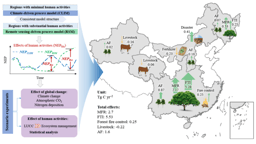Greening Pakistan: How Forests Sustain Human Health
Published in Earth & Environment, Sustainability, and Public Health

Greening Pakistan: How Forests Sustain Human Health
As Pakistan continues to grapple with the impacts of rapid urbanization, climate change, and declining biodiversity, forests emerge not only as environmental guardians but also as lifelines for human health. These green ecosystems provide far more than timber or scenic beauty—they purify air and water, regulate temperature, reduce stress, and prevent disease. Strengthening the forest-human health connection can be a cornerstone for building a healthier, more sustainable Pakistan.
The Forest-Health Connection: What Science Tells Us
Research from around the world underscores the profound impact forests have on public health. Trees act as natural air filters, absorbing pollutants like carbon dioxide, sulfur dioxide, and nitrogen oxides while releasing life-sustaining oxygen. In urban areas, this function becomes critical, as air pollution is a major contributor to respiratory illnesses, cardiovascular diseases, and premature deaths.
Exposure to green environments is also linked to improved mental health. Studies show that time spent in forests can reduce cortisol levels, lower blood pressure, and enhance mood and cognitive function. For a country like Pakistan—where mental health issues are often under-addressed—natural landscapes offer an accessible and cost-effective therapeutic resource.
Forest Ecosystems as Public Health Infrastructure
In Pakistan’s rural and mountainous regions, forests play an essential role in water security and disease prevention. Forested watersheds regulate rainfall and recharge groundwater, supporting clean water supplies and reducing the incidence of waterborne illnesses. Meanwhile, biodiversity in forest ecosystems contributes to the discovery of medicinal plants and bioactive compounds used in traditional and modern medicine.
Importantly, forests also serve as natural buffers against extreme weather events. As climate change fuels more frequent and severe floods, heatwaves, and droughts in Pakistan, forest cover helps stabilize local climates, store carbon, and protect vulnerable communities—especially in flood-prone and arid areas.
Challenges and Opportunities in Pakistan
Despite these benefits, Pakistan has one of the lowest forest-to-land ratios in the region, with just around 5% forest cover. Deforestation driven by agricultural expansion, illegal logging, and urban sprawl continues to threaten ecosystem services and human well-being.
However, initiatives like the Ten Billion Tree Tsunami Program have shown promise in restoring degraded landscapes and increasing tree cover. Beyond tree-planting, sustainable forest management and community-based conservation are vital to ensure long-term ecological health and socio-economic benefits.
Urban forestry—such as planting trees along roads, parks, schools, and hospitals—can bring health benefits closer to people, especially in heavily populated cities like Lahore, Karachi, and Islamabad.
A Call to Action
To fully harness the health benefits of forests, Pakistan needs integrated policies that link environmental sustainability with public health. Awareness campaigns, green infrastructure planning, and the promotion of nature-based therapies can all contribute to healthier communities.
Investing in forests is investing in human health. As we plant trees and protect woodlands, we also sow the seeds for cleaner air, stronger minds, safer water, and climate resilience. A greener Pakistan is not just an environmental goal—it is a public health imperative.
Follow the Topic
What are SDG Topics?
An introduction to Sustainable Development Goals (SDGs) Topics and their role in highlighting sustainable development research.
Continue reading announcement





Please sign in or register for FREE
If you are a registered user on Research Communities by Springer Nature, please sign in
Amanullah, A., & Khan, U. (2024). Forests and Human Health: A Symbiotic Relationship for Greener Pakistan. Jurnal Perencanaan Pembangunan: The Indonesian Journal of Development Planning, 8(2), 181–190. https://doi.org/10.36574/jpp.v8i2.552